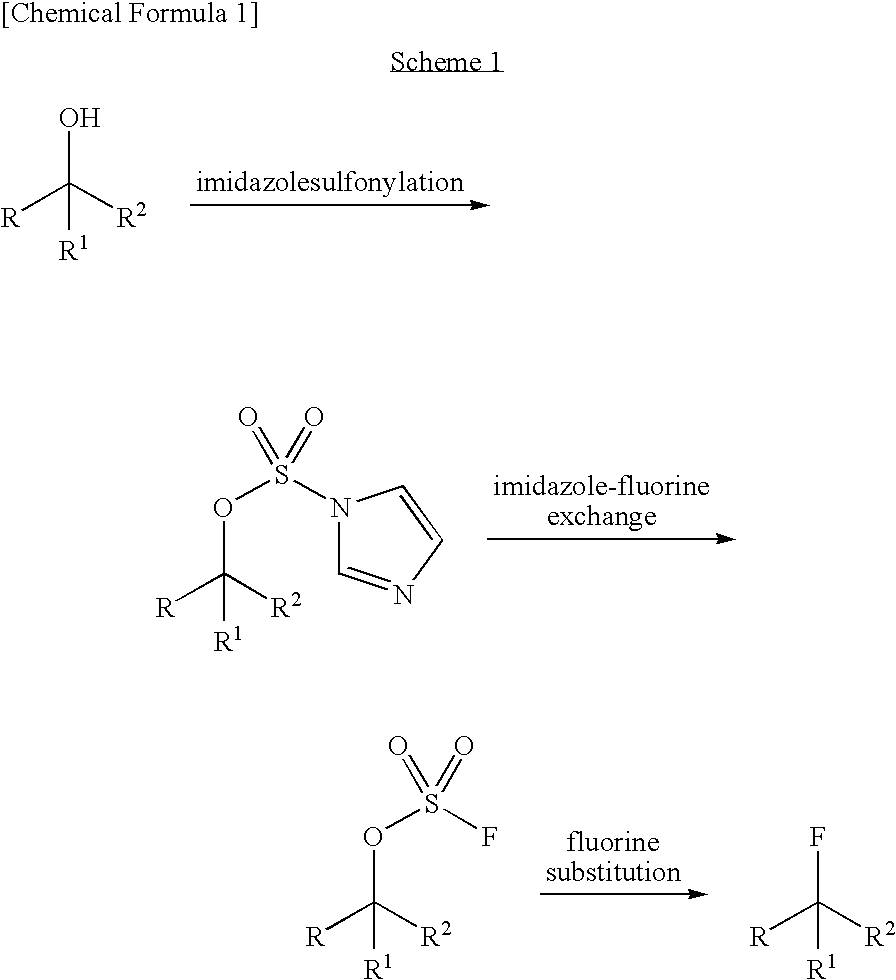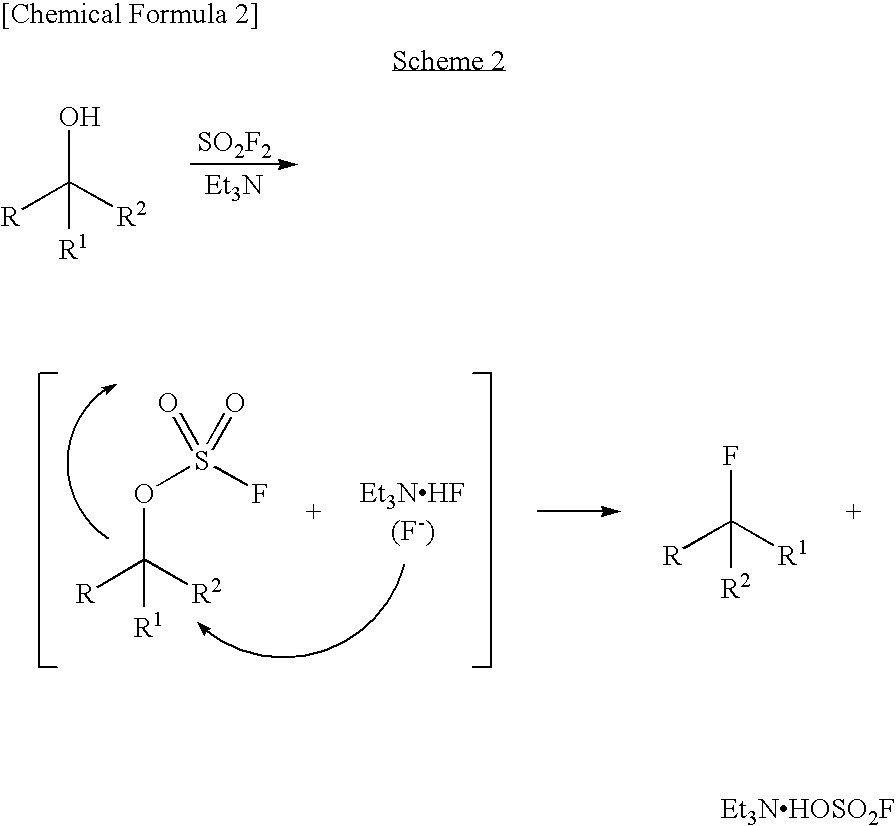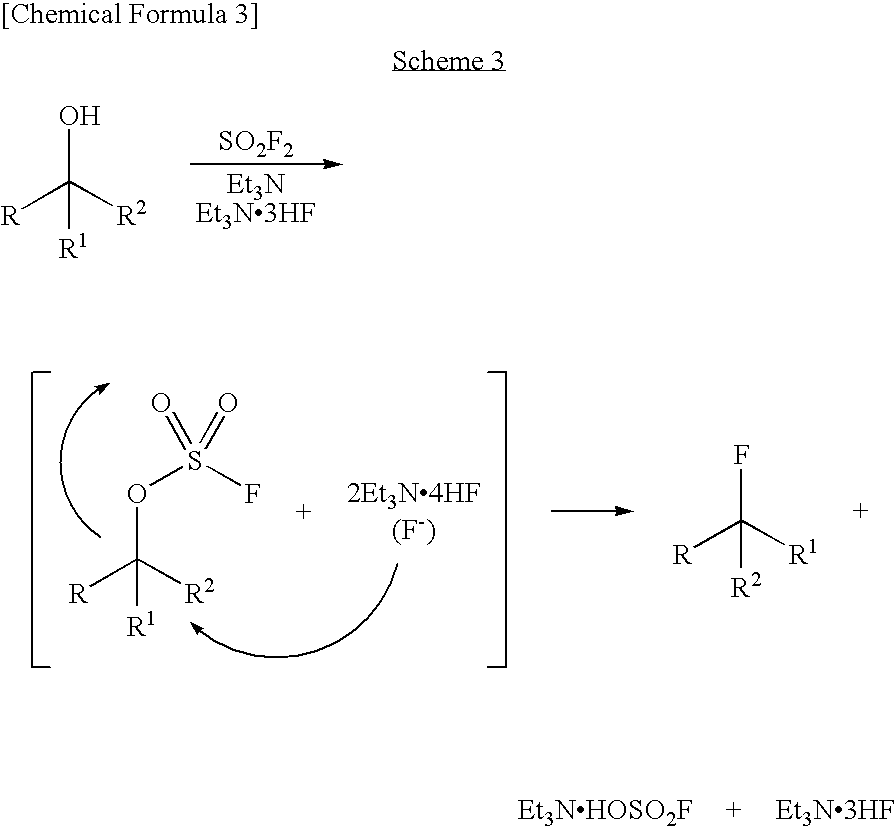Process for production of fluoro derivative
a technology of fluoro derivatives and production processes, which is applied in the preparation of halogenated hydrocarbons, carboxylic acid halides, carboxylic compound preparations, etc., can solve the problems of large acid waste treatment, limited industrial use, and limited industrial production of trifluoromethanesulfonyl fluoride, etc., to achieve efficient production and high selectivity
- Summary
- Abstract
- Description
- Claims
- Application Information
AI Technical Summary
Benefits of technology
Problems solved by technology
Method used
Image
Examples
example 1
[0116]A pressure-proof reaction vessel made of stainless steel (SUS) was charged with 2.45 g (9.99 mmol, 1.00 eq) of 4-hydroxyproline derivative represented by the following formula,
[0117]
10.0 mL of acetonitrile, and 1.10 g (10.87 mmol, 1.09 eq) of triethylamine, followed by lowering the inside temperature to −40° C. and then bubbling 2.00 g (19.60 mmol, 1.96 eq) of sulfuryl fluoride from a cylinder. The inside temperature was returned to room temperature, and stirring was conducted for 20 hours and 20 minutes. Conversion of the reaction was found by gas chromatography measurement to be 100%. The reaction-terminated liquid was poured into a potassium carbonate aqueous solution [prepared from 2.80 g (20.26 mmol, 2.03 eq) of potassium carbonate and 50.0 mL of water], followed by extraction two times with 50.0 mL of ethyl acetate. The recovered organic layer was concentrated under reduced pressure, followed by vacuum drying, thereby obtaining a crude product of 4-fluoroproline derivati...
example 2
[0121]A pressure-proof reaction vessel made of stainless steel (SUS) was charged with 2.45 g (9.99 mmol, 1.00 eq) of 4-hydroxyproline derivative represented by the following formula,
[0122]
13.0 mL of acetonitrile, 3.50 g (34.59 mmol, 3.46 eq) of triethylamine, and 1.60 g (9.92 mmol, 0.99 eq) of triethylamine tris(hydrogen fluoride) complex, followed by lowering the inside temperature to −40° C. and then bubbling 2.00 g (19.60 mmol, 1.96 eq) of sulfuryl fluoride from a cylinder. The inside temperature was returned to room temperature, and stirring was conducted for 20 hours. Conversion of the reaction was found by gas chromatography measurement to be 100%. The reaction-terminated liquid was poured into a potassium carbonate aqueous solution [prepared from 6.30 g (45.58 mmol, 4.56 eq) of potassium carbonate and 100.0 mL of water], followed by extraction two times with 100.0 mL of ethyl acetate. The recovered organic layer was concentrated under reduced pressure, followed by vacuum dryi...
example 3
[0124]A pressure-proof reaction vessel made of stainless steel (SUS) was charged with 12.30 g (29.82 mmol, 1.00 eq) of 1-β-D-arabinofuranosyluracil derivative represented by the following formula,
[0125]
38.0 mL of acetonitrile, 18.15 g (179.37 mmol, 6.02 eq) of triethylamine, and 19.30 g (119.71 mmol, 4.01 eq) of triethylamine tris(hydrogen fluoride) complex, followed by lowering the inside temperature to −40° C. and then bubbling 10.00 g (97.98 mmol, 3.29 eq) of sulfuryl fluoride from a cylinder. The inside temperature was returned to room temperature, and stirring was conducted for 16 hours and 30 minutes and then at 40° C. for 5 hours and 30 minutes. Conversion of the reaction was found by liquid chromatography measurement to be not lower than 99%. The reaction-terminated liquid was poured into a potassium carbonate aqueous solution [prepared from 58.00 g (419.65 mmol, 14.07 eq) of potassium carbonate and 300.0 mL of water], followed by extraction two times with 300.0 mL of ethyl ...
PUM
| Property | Measurement | Unit |
|---|---|---|
| boiling point | aaaaa | aaaaa |
| boiling point | aaaaa | aaaaa |
| carbon number | aaaaa | aaaaa |
Abstract
Description
Claims
Application Information
 Login to View More
Login to View More - R&D
- Intellectual Property
- Life Sciences
- Materials
- Tech Scout
- Unparalleled Data Quality
- Higher Quality Content
- 60% Fewer Hallucinations
Browse by: Latest US Patents, China's latest patents, Technical Efficacy Thesaurus, Application Domain, Technology Topic, Popular Technical Reports.
© 2025 PatSnap. All rights reserved.Legal|Privacy policy|Modern Slavery Act Transparency Statement|Sitemap|About US| Contact US: help@patsnap.com



